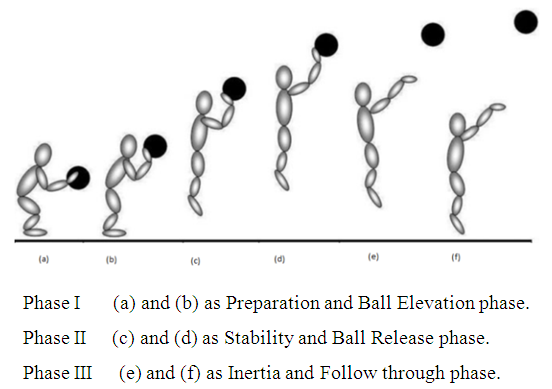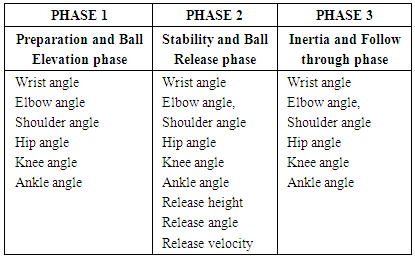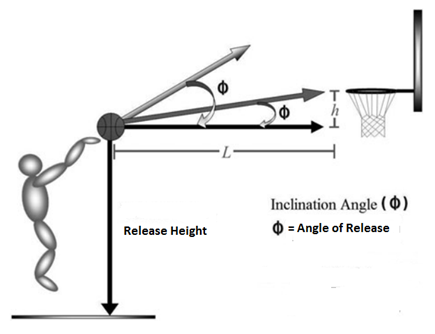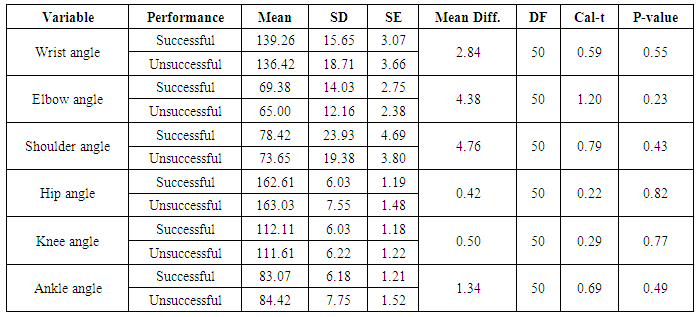Ikram Hussain, Fuzail Ahmad, Nidhi Rani
Department of Physical Education, Aligarh Muslim University, Aligarh, India
Correspondence to: Fuzail Ahmad, Department of Physical Education, Aligarh Muslim University, Aligarh, India.
| Email: |  |
Copyright © 2017 Scientific & Academic Publishing. All Rights Reserved.
This work is licensed under the Creative Commons Attribution International License (CC BY).
http://creativecommons.org/licenses/by/4.0/

Abstract
This paper mainly used the two dimensional videograph analysis technique to analyze the Three Point Shoot performance of Basketball and to acquire relevant bio-kinematics parameters of the execution of the motion at three different positions ie: right side guard position, left side guard position and centre position. Mainly including the loss rate of body horizontal and vertical velocity of the ball, Wrist angle, Elbow angle, Shoulder angle, Hip angle, Knee angle, Ankle angle, Release height, Release angle and Release velocity, in order to analyze the recording in a more convenient way, we divide Three Point Shooting exertion movement in three phases as Preparation and Ball Elevation phase, Stability and Ball Release phase and Inertia and Follow through phase. Six highly skilled active, north zone intervarsity level, right handed shooters male basketball players were participated in this study. During the Three Point Shooting stages, the initial release shooting velocity of the basketball is 6.89 m/s. The average angle of throwing ball is about 46.61°, with the mean of posture angle remain as 184.52°. And the releasing height of the ball is 2.33 m. This investigation provides kinematics indicators and technical guidance for the training of Three Point Shoot for basketball players.
Keywords:
Three Point Shoot, Two dimensional analyses, Bio-kinematic, Guard positions
Cite this paper: Ikram Hussain, Fuzail Ahmad, Nidhi Rani, Investigation of Bio-Kinematic Elements of Three Point Shoot in Basketball, International Journal of Sports Science, Vol. 7 No. 4, 2017, pp. 163-169. doi: 10.5923/j.sports.20170704.02.
1. Introduction
Basketball is a popular sport in the world. Basketball is founded in January, 1892, though it has been ignored by people in the latter half century, after Berlin Olympic Games in 1936, it is fast popular all around the world, while in modern times, basketball national level competitions mainly are China CBA, America NBA. International competitions mainly include basketball world championship, Olympic Games, Stankovic Cup (Guang, 2014). Basketball players need to put much effort on training shooting skill and try their best to stop opponents to score in a game. Therefore shooting technique is one of the core techniques in basketball movement. Excellent basketball shooters have a beautiful arch, input the proper backspin, and minimize the lateral deviation from the optimal shot path plane. They manipulate their shoulder, elbow and wrist to produce the optimal ball speed, angle and angular velocity at release. It is vital to analyze the kinematics of the shooting arm to understand good shooting. Knudson (1993) proposed six key teaching points for jump shots based on many basketball shooting studies, and mentioned that biomechanical studies have not clearly identified the optimal coordination of human joint actions.Shooting is the basic way to get score in basketball and for this reason it is the most frequently used technical action (Hey, 1994). The jump shot is distinguished as the most important of all the shooting actions (Hess, 1980). Miller (1996) has discussed the relationship between basketball shooting kinematics, distance and playing position. Chin (2002) also analyzed the basketball shooting of different distances and movements. Some previous studies (Elliott, 1992; Miller & Bartlett, 1993; Okazaki & Rodacki, 2012) measured shooters’ shoulder, elbow and wrist joint motions at release for shooting, and reported the effect of increased shooting distance. In this paper, we weigh against successful and unsuccessful kinematics of Three Point Shooting at different positions and find out key actions of the selected kinematics to produce the optimal release speed, angle and backspin in executing the Three Point Shooting motion at left & right guard position and center position.
2. Methodology
Six highly skilled active, right handed shooters male and female basketball players were participated in this study. All players were playing in north zone intervarsity level. All of the participants were practicing according to their team’s regular training schedule. All the subjects were playing from all the post guards, forwards, and centers. The participants were free of any kind of musculoskeletal injuries at the time of data collection. The placement of the cameras and the calibration frame was adjusted accordingly to the experimental setup and motion of the execution of the Three Point Shoot.  | Figure 1. Illustration of the motion of Three Point Shoot |
2.1. Selected Variables
In three point basketball shooting different parameters play a great role for making a shot ‘successful’ and ‘unsuccessful’ shooting in the performance such as psychology, physiology and anthropometry of the player and etc. But here researcher selected only the biomechanical parameters, and worked on it and try to find out the effect of selected biomechanical parameters on the successful and unsuccessful three Point Shoot of basketball. The selected biomechanical variables in the study were as:
2.2. Procedure of Biomechanical Analysis
The researcher selected the standard basketball court for data collection. The experimental set-up was arranged on the half side of the court for the research data in the department of Physical Education, Aligarh Muslim University, Aligarh. The 3D point shooting area was selected for the study. The three positions of data collection was (1) shooting right side guard position, (2) left side guard position, and (3) centre position. The motion of the shooting was recorded on the right side of the 3 D point shooting area. Two Canon HF S-10 cameras were adopted for the process of Videography. The camera placed on the right side of the motion to capture on the sagittal plane was coined as Cam_1 and Cam_2 respectively. The first camera was placed perpendicular to the body position of the subject to capture the movement of the subjects for close-up recording and the second was placed behind of the first camera and perpendicular to the height of release of the ball position capturing the whole motion of the ball from the hand of the subject after release to the basket or ring. Three experimental setups was arranged and layout to capture the movement of the Three Point Shoot as Setup A, Setup B and Setup C for the recording of the Three Point Shoot executed on right side guard position, Center position and left side guard position respectively [Figure: 2, 3, 4, 5]. All six subjects of the study were educated for the data collection. The markers were placed on the subject’s right wrist joint point, elbow joint point, shoulder joint point, hip joint point, knee joint point, ankle joint point, toe and heel respectively. The instruction about data collection and warm-up time was provided to the subjects. The video cameras were set on 1/2000 of shutter speed and were put on recording mode for the video recording. After warm-up every subjects performed Three Point Shooting ten times on all the setups (ie: Setup A, Setup B & Setup C). Three best trails were selected after playing various times on the video playback system and the best-suited trails have opted. The shortlisted trails were slashed and edited. The edited videos were analyzed with the help of Silicon Coach Pro 8.1 Motion analysis to obtain the data for further analysis. In this study Wrist angle, Elbow angle, Shoulder angle, Hip angle, Knee angle, Ankle angle, Release height, Release angle and Release velocity were measured to draw and built the conclusion. The wrist angle measured between palm and forearm. The Elbow angle measured between forearm and upper arm. The shoulder angle measured between torso and upper arm. The hip angle was measured between torso and upper leg. The knee angle was measured between upper leg and lower leg. The ankle angle was measured between lower leg and foot. The release height was measured by the vertical distance from the floor to the center of the ball. The release angle of the ball was measured when the ball release from the players hand in execution phase. The release velocity measured by the speed of the ball at the time of execution. The trajectory was observed from ball release to the drop of the in the basket or ring. | Figure 2. Point of Location of Data Collection as Right and Left Guard Position and Center Position |
 | Figure 3. Experiment Set-up A at Right Guard Position. Camera 1 placed 9.50 meter away from the plane of execution, at 1.28 meter high and Camera 2 placed at 15.40 meter, at 1.56 meter high |
 | Figure 4. Experiment Set-up B at Right Guard Position. Camera 1 placed 10.40 meter away from the plane of execution, at 1.28 meter high and Camera 2 placed at 13.27 meter away, at 1.80 meter high |
 | Figure 5. Experiment Set-up C at Right Guard Position. Camera 1 placed 7.52 meter away from the plane of execution, at 1.30 meter high and Camera 2 placed at 12.11 meter, at 1.45 meter high |
2.3. Procedure of Criterion Measurement for Testing
 | Figure 6. Illustration of the measurement of Release height and angle of release |
2.4. Statistical Procedure
The acquired data was given an appropriate statistical treatment to draw a conclusion in this investigation. In this study, descriptive statistics were applied to the successful and unsuccessful shot; mean and standard deviation of all variables were computed in the first phase of data analysis. In the second phase paired t-test was applied to know the difference in the selected biomechanical variables between the successful and unsuccessful Three Point Shoot. All statistical functions were performed with the SPSS (v.17) software. In all statistical analyses, the significance threshold was set at p< 0.05. The degree of freedom was 50. | Figure 7. Measurement of Release angle, entry angle, and release height of ball at the time of execution through Silicon Coach |
3. Result and Discussion
Table 1. Descriptive statistics of the Democratic profile of the subjects
 |
| |
|
The purpose of the present study was to determine the kinematic influence for the selected fundamental skill ie: Three Point Shooting. This skill is divided into three phases such as Phase I Preparation and Ball Angle, Phase II Stability and Ball Release, Phase III Inertia and Follow Through. In phase I, the parameters wrist angle, elbow angle, shoulder angle, hip angle, knee angle, ankle angle, were selected for the analysis; Table 2 reveal the result that no significant differences are found in the body joints angles during the phase I, but there were calculation differences (random) between the successful and unsuccessful shooting (Diar, 2014). During the study it was observed that the wrist angle displayed for successful Three Point Shoot as Mean ± SD = 139.26 ± 15.65 and for unsuccessful Three Point Shoot Mean ± SD = 139.42 ± 18.71, The elbow angle for successful Three Point Shoot as Mean ± SD = 69.38 ± 14.03 and for unsuccessful shot Mean ± SD = 65.00 ± 12.16. Shoulder angle for successful & unsuccessful as 78.42 ± 23.93 & 73.65 ± 19.38 respectively. The subjects displayed hip angle for successful as 162.61 ± 6.03 and 163.03 ± 7.55 for unsuccessful. The knee angle and ankle angle for successful shot were 112.11 ± 6.03 & 84.42 ± 7.75, whereas for unsuccessful as 111.61 ± 6.22 & 83.07 ± 6.18 respectively. No significant changes were showed on Knee angle and ankle at the initial stage (extension) of the execution (Diar, 20214; Nassaif & Mazer, 1979). The p>0.05 for the all the body angles examined during phase I. Least mean difference among the selected kinematics variables were observed between the successful and unsuccessful during Three Point Shoot.Table 3, shows significant difference in shoulder angle in making the score during Stability and Ball Release phase. The selected parameters for the phase II were wrist angle, elbow angle, shoulder angle, hip angle, knee angle, ankle angle, release height, release angle and release velocity. The wrist angle for successful & unsuccessful are 142.88 ± 1.39 & 145.57 ± 14.98 and elbow angle shows 155.11 ± 17.92 & = 150.84 ± 15.28 (as Mean ± SD). But both wrist and elbow angle displays a no significant result. Similarly, Diehl, Tant, Emmoms, Osbon shows 175.20 as wrist and 157.8 as elbow angle in his study which was also not significant.Table 2. Comparison of Kinematic variables in Preparation and Ball Angle phase during Three Point Shoot among Boys
 |
| |
|
 | Graph 1. Graphical representation of Means of the selected kinematic variables of Successful and Unsuccessful Three Point Shoot of Boys Basketball Players during Preparation and Ball Angle phase |
Table 3. Phase II Stability and Ball Release among Boys
 |
| |
|
The mean and sd for shoulder angle for successful Three Point Shoot is 119.50 ± 9.83 and for unsuccessful it is 114.50 ± 8.39. Diar, 2014 and Rojas, 2000 also supports that a significant result in angle of shooting arm shoulder joint at the end of the preparatory phase was showed due to the player is used to lap the ball near his chest with full flexion of the elbow joint. Shoulder angle towards the end of the pushing in flight in favor of shot in making it successful. Hip angle, the boys display the hip angle for successful as 184.07 ± 3.85 and for unsuccessful as 184.96 ± 4.57. The 5th variable knee angle, the boys display the knee angle for successful Three Point Shoot as Mean ± SD = 168.88 ± 7.96 and for unsuccessful Three Point Shoot Mean ± SD = 171.26 ± 8.31. No significant change was observed in the angular contrast for the knee joint at the ball release stage (Rojas, 2000). And the ankle angle successful Three Point Shoot was 131.96 ± 9.32 and for unsuccessful 134.88 ± 5.79.Chung et al. (2004) suggest that the ball release from finger was a key factor; the kinematics chain was from the shank, thigh, trunk, upper arm and forearm segments which also influences release height. Comparable outcome has being promoted by this examination, release height was 233.43 ± 12.89 (cm) for successful, whereas for unsuccessful the Mean ± SD was 232.25 ± 15.21(cm). The ball variables as release angle and release velocity for successful and unsuccessful Three Point Shoot are also shown as not significant in this study, with very least mean difference as 0.70 & 0.27.Inertia and Follow Through is the third and last phase of the Three Point Shoot. Table 4, shows wrist angle as the only significant value among all the selected variables. Wrist flexion in the meantime and the forefinger compel set out toward the end is accord with human body development mechanics principle, index finger, and metacarpal is one of the longest, in this way, the longest and the working separation to dial out to the ball from this side, is useful to quicken the speed and exactness of basketball accuracy (Zhen, 2015). | Graph 2. Graphical representation of Means of the selected kinematic variables of Successful and Unsuccessful Three Point Shoot of Boys Basketball Players during Stability and Ball Release phase |
Table 4. Phase III Inertia and Follow Through among Boys
 |
| |
|
From table 4 it was observed wrist angle for successful as 149.42 ± 12.91and for unsuccessful as 141.80 ± 13.82. The elbow angle as 156.80 ± 18 & 154.76 ± 19.03. Shoulder angle as 114.73 ± 31.09 and as 106.00 ± 28.01 respectively. The mean and SD of lower extremities as hip, knee and ankle angles for successful Three Point Shoot are 171.50 ± 10.77, 160.19 ± 5.73 and 113.96 ± 11.37, whereas for unsuccessful 173.15 ± 9.82, 161.46 ± 5.68 and 117.30 ± 8.37 respectively. No significant changes were showed on Hip, Knee and Ankle angle at the end of absorption stage (flexion).In general, no significant differences were see final variables of the body joints angles and the ball variables except the shoulder angle during Stability and Ball Release shot arm's shoulder jointed-push stage during flying of ball and wrist angle during Inertia and Follow Through for providing the direction and spin to make the three point successful to be attempt at random differences from any position out of three shot line. We have referred to shortcomings in the angles of the starting body.  | Graph 3. Graphical representation of Means of the selected kinematic variables of Successful and Unsuccessful Three Point Shoot of Boys Basketball Players during Inertia and Follow Throughphase |
4. Conclusions
Three Point Shooting abilities contain an assortment of laws and principles of human movement, among them, the development mechanics content assumes a significant part. While shooting from any position out of three point line, elbow ought to aim at the ring. Shoulder, elbow, wrist, fingers and the ball ought to be on a similar plane of the movement, in this way when the ball is tossed towards the basket ring for the successful score. In the meantime, players likewise need to utilize fingers to control and shoot the ball. The pointing point ought to be the rear edge of the basket ring, in light of the fact that in the wake of discharging the shot, the ball is turning noticeable all around. Considering the parabolic trajectory the ball may go into the basket ring when going for the trailing edge of the basketball ring, the scoring rate will be approx. 70.00% higher.
References
| [1] | Dair, M. S. (2014). Comparison some of Biomechanics Variables to Jump Shot from a 45° Angle from the Area of the Three Points in Front of the Defender or without for the Player and Ball in Basketball. Analytical Research. International Journal of Advanced Sport Sciences Research, Vol. 2(2), 137-146. |
| [2] | Elliott, B. (1992). A kinematic comparison of the male and female two-point and three-point jump shots in basketball, Australian J. Science and Medicine in Sport. Vol. 24, 111-118. |
| [3] | Guang, L. (2014). Basketball shooting angle and movement trajectory correlation research based on differential model. BTAIJ, Vol. 10(2), 143-148. |
| [4] | Hay, T. G. (1985). The Biomechanics of Sports Techniques. Englewood Cliffs, N. J. |
| [5] | Knudson, D. (1993). Biomechanics of the basketball jump shot – Six key teaching points, J. Physical Education, Recreation, and Dance. Vol. 64, 67-73. |
| [6] | Miller, S. & Bartlett, R. (1996). The Relationship between Basketball Shooting Kinematics, Distance and Playing Position. Journal of Sports Sciences, Vol. 14, 243-253. |
| [7] | Miller, S. & Bartlett, R. M. (1993). The effects of increased shooting distance in the basketball jump shot, J. Sports Sciences. Vol. 11, 285-293. |
| [8] | Nassaif A. A. & Mazer K., (1979). Biomechanics, Port Press, Baghdad, 72. |
| [9] | Okazaki, V.H.A. & Rodacki, A.L.F. (2012). Increased distance of shooting on basketball jump shot, J. Sports Science and Medicine, Vol. 11, 231- 237. |
| [10] | Zhen, L., Wang, L & Hao Z. (2015). A Biomechanical Analysis of Basketball Shooting. International Journal of Simulation Systems, Science & Technology. Vol. 16(1). 1.1-1.5. |













 Abstract
Abstract Reference
Reference Full-Text PDF
Full-Text PDF Full-text HTML
Full-text HTML



